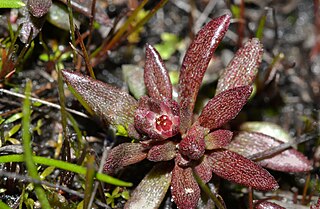
Trillium is a genus of about fifty flowering plant species in the family Melanthiaceae. Trillium species are native to temperate regions of North America and Asia, with the greatest diversity of species found in the southern Appalachian Mountains in the southeastern United States.

The Crassulaceae, also known as the stonecrop family or the orpine family, are a diverse family of dicotyledon flowering plants characterized by succulent leaves and a form of photosynthesis, known as Crassulacean acid metabolism (CAM). Flowers generally have five floral parts. Crassulaceae are usually herbaceous but there are some subshrubs, and relatively few treelike or aquatic plants. Crassulaceae are a medium-sized monophyletic family in the core eudicots, among the order Saxifragales, whose diversity has made infrafamilial classification very difficult. The family includes approximately 1,400 species and 34–35 genera, depending on the circumscription of the genus Sedum, and distributed over three subfamilies. Members of the Crassulaceae are found worldwide, but mostly in the Northern Hemisphere and southern Africa, typically in dry and/or cold areas where water may be scarce, although a few are aquatic.

Crassula is a genus of succulent plants containing about 200 accepted species, including the popular jade plant. They are members of the stonecrop family (Crassulaceae) and are native to many parts of the globe, but cultivated varieties originate almost exclusively from species from the Eastern Cape of South Africa.

Vachellia sieberiana, until recently known as Acacia sieberiana, is a tree native to southern Africa and introduced into Pakistan. It is used in many areas for various purposes. The tree varies from 3 to 25 m in height, with a trunk diameter of 0.6 to 1.8 m. It is not listed as being a threatened species.

Crassula connata is a succulent plant in the family Crassulaceae. It is known by the common names sand pygmyweed and pygmy stonecrop. It is a very small plant which grows in patches on the ground, especially in rocky areas. It is also sometimes associated with vernal pool plant communities. The stems are a few centimeters in length and are covered with tiny fleshy pointed leaves. Each leaf is only millimeters long. The plant is green when new and it matures to shades of pink and red. It is found in western North America and in parts of Central and South America.

Crassula helmsii, known as swamp stonecrop or New Zealand pigmyweed, is an aquatic or semiterrestrial species of succulent plant in the family Crassulaceae. Originally found in Australia and New Zealand, it has been introduced around the world. In the United Kingdom, this plant is one of five introduced invasive aquatic plants that were banned from sale from April 2014, the first ban of its kind in the country. It is on the Global Biodiversity Information Facility's Global Register of Introduced and Invasive Species of eleven countries.
Crassula colorata, the dense pigmyweed or dense stonecrop, is an annual plant in the family Crassulaceae. The species is endemic to Australia, occurring in Western Australia, South Australia, New South Wales and Victoria.

In botany, succulent plants, also known as succulents, are plants with parts that are thickened, fleshy, and engorged, usually to retain water in arid climates or soil conditions. The word succulent comes from the Latin word sucus, meaning "juice" or "sap".

Gahnia sieberiana, commonly known as the red-fruit saw-sedge, is a tussock-forming perennial plant in the family Cyperaceae, endemic to Australia. It is a widespread plant that favours damp sunny sites. Many insect larvae have been recorded feeding on the red-fruit saw-sedge. It may grow over 2 metres tall.

Poa sieberiana, commonly known as grey tussock-grass and snow grass, is a species of tussock grass that is endemic to Australia.

Crassula alata is a herb in the family Crassulaceae. It is native to the Mediterranean basin and is now also found in southern Australia and New Zealand. The succulent annual herb typically grows to a height of 5 centimetres (2.0 in). It produces white flowers in the spring time between August and October in the southern hemisphere.

Crassula closiana is a herb in the family Crassulaceae that is native to Western Australia.

Crassula colligata is a herb in the family Crassulaceae that is native to southern Australia and New Zealand.

Crassula decumbens, commonly known as rufous stonecrop, cape crassula or spreading crassula, is a herb in the family Crassulaceae that is native to southern parts of Australia, South Africa, and Chile. There are generally two accepted varieties: Crassula decumbens var. decumbens and C. decumbens var. brachyphylla.
Crassula natans, commonly known as floating pigmyweed, is a herb in the family Crassulaceae.
Hellmut R. Toelken is a South Australian botanist. He retired in December 2008 from the position of senior biologist at the State Herbarium of South Australia, but remains an honorary research associate. Earlier he was with the Botanical Research Institute, Department of Agricultural Technical Services, Pretoria, S Africa.

Crassula subaphylla is a succulent plant belonging to the family Crassulaceae. It is widespread in the Karoo regions of South Africa and Namibia.

Crassula pellucida is a creeping, succulent ground-cover, or low-growing, spreading succulent shrub. It is native to eastern and southern Africa, ranging from Kenya and Angola to South Africa.

Crassula perfoliata is the type species of the genus Crassula, in the succulent/flowering plant family Crassulaceae, where it is placed in the subfamily Crassuloideae. Formally described by Linnaeus in 1753 as one of 10 species of Crassula, the plant is endemic to Southern Africa, where it may be found in Eswatini, Mozambique, South Africa and Zimbabwe.
Folland Park is a fenced, 3.5-hectare reserve in the suburb of Enfield, South Australia. It is owned by the City of Port Adelaide Enfield, and consists of significant remnant vegetation that once covered much of the Adelaide Plains. The park is of special significance to botanists, and is under a heritage agreement to conserve its native vegetation and fauna.
















